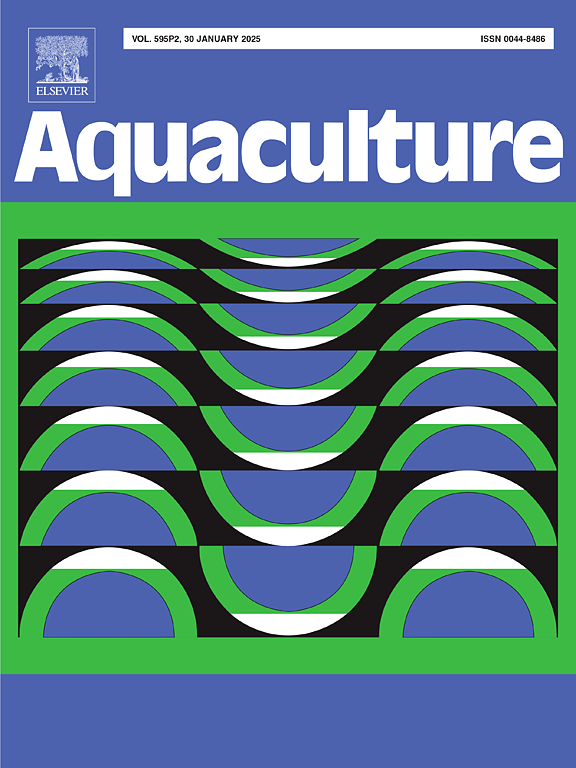Arachidonic acid promotes ovarian development by modulating lipid metabolism and steroid hormone secretion in Chinese mitten crab (Eriocheir sinensis)
IF 3.9
1区 农林科学
Q1 FISHERIES
引用次数: 0
Abstract
In this study, two animal experiments were designed to assess the function of arachidonic acid (ARA) on the ovarian development of Chinese mitten crab (Eriocheir sinensis). In experiment 1, female crabs (35.55 ± 0.02 g) were fed seven experimental diets, each containing varying levels of ARA (0.01 %, 0.28 %, 0.48 %, 0.67 %, 0.86 %, 1.02 %, and 1.21 %) for 120 d. Dietary 0.48 %–0.86 % ARA significantly improved the growth performance of crabs, and more than dietary 0.67 % ARA significantly increased the gonadosomatic index (GSI), ovarian vitellogenin (VTG) and vitellin (Vn) contents (P < 0.05). The egg diameter was largest when dietary 0.86 % ARA. Moreover, dietary ARA also significantly affected the hepatopancreatic and ovarian fatty acid compositions and ARA content by increasing the relative expressions of phospholipase A2 (pla2), cyclooxygenase-1(cox-1), cyclooxygenase-2 (cox-2) and 5-lipoxygenase (5-lox), while decreasing the relative expressions of fatty acid synthase (fas), fatty acid desaturase (fad6), lipoprotein lipase (lpl) and fatty acid elongase (elo) (P < 0.05). Based on the GSI and egg diameter, the amount of 0.86 % ARA was selected to further investigate the mechanisms involved in ovarian development. In experiment 2, female crabs (73.34 ± 0.07 g) were fed ARA diets (0.01 % and 0.86 %) for 60 d. Results demonstrated that a diet supplemented with 0.86 % ARA notably increased the progesterone (PROG) and prostaglandins (PGs) contents in hepatopancreas, as well as the thromboxane A2 (TXA2), estradiol (E2), and estriol (E3) contents in ovaries of E. sinensis (P < 0.05). Immunohistochemical analyses showed that 0.86 % ARA significantly promoted the expression of E2 receptor. Moreover, transcriptome sequencing revealed that 15 KEGG pathways, including the mTOR and FoxO signalling pathways and steroid biosynthesis, were enriched in the differentially expressed genes (DEGs) of crabs fed 0.86 % ARA. In conclusion, dietary 0.86 % ARA accelerated the deposition of ARA in the hepatopancreas and ovaries by regulating ARA synthesis and metabolism-related genes, then subsequently providing energy for ovarian development. Meanwhile, ARA promoted steroid hormone secretion and ovarian development-related pathways by facilitating the generation of PGs and ultimately promoted ovarian development in Chinese mitten crabs.
花生四烯酸通过调节中华绒螯蟹的脂质代谢和类固醇激素分泌促进卵巢发育
本研究设计了两个动物实验来评估花生四烯酸(ARA)对中华绒螯蟹卵巢发育的作用。在实验 1 中,雌性中华绒螯蟹(35.55 ± 0.02 g)被喂食七种实验日粮,每种日粮含有不同水平的 ARA(0.01 %、0.28 %、0.48 %、0.67 %、0.86 %、1.02 % 和 1.21 %),持续 120 d。86%的ARA能明显改善河蟹的生长性能,比0.67%的ARA更能明显提高性腺指数(GSI)、卵巢卵黄素(VTG)和卵黄素(Vn)的含量(P <0.05)。当日粮中 ARA 含量为 0.86 % 时,蛋的直径最大。此外,日粮 ARA 还通过增加磷脂酶 A2 (pla2)、环氧化酶-1 (cox-1)、环氧化酶-2 (cox-2)的相对表达量,显著影响肝胰腺和卵巢的脂肪酸组成和 ARA 含量、环氧化酶-2(cox-2)和 5-脂氧合酶(5-lox)的相对表达量增加,而脂肪酸合成酶(fas)、脂肪酸去饱和酶(fad6)、脂蛋白脂肪酶(lpl)和脂肪酸伸长酶(elo)的相对表达量减少(P <;0.05).根据 GSI 和卵直径,选择 0.86 % ARA 的用量来进一步研究卵巢发育的相关机制。在实验 2 中,雌蟹(73.34 ± 0.07 g)喂食 ARA 日粮(0.01 % 和 0.86 %)60 d。86%的 ARA 显著增加了中华绒螯虾肝胰腺中孕酮(PROG)和前列腺素(PGs)的含量,以及卵巢中血栓素 A2(TXA2)、雌二醇(E2)和雌三醇(E3)的含量(P <0.05)。免疫组化分析表明,0.86 % ARA 能显著促进 E2 受体的表达。此外,转录组测序显示,15 个 KEGG 通路(包括 mTOR 和 FoxO 信号通路以及类固醇生物合成)富集在喂食 0.86 % ARA 的螃蟹的差异表达基因(DEGs)中。总之,膳食 0.86 % ARA 可通过调节 ARA 合成和代谢相关基因,加速 ARA 在肝胰腺和卵巢中的沉积,进而为卵巢发育提供能量。同时,ARA通过促进PGs的生成,促进类固醇激素的分泌和卵巢发育相关途径,最终促进中华绒螯蟹的卵巢发育。
本文章由计算机程序翻译,如有差异,请以英文原文为准。
求助全文
约1分钟内获得全文
求助全文
来源期刊

Aquaculture
农林科学-海洋与淡水生物学
CiteScore
8.60
自引率
17.80%
发文量
1246
审稿时长
56 days
期刊介绍:
Aquaculture is an international journal for the exploration, improvement and management of all freshwater and marine food resources. It publishes novel and innovative research of world-wide interest on farming of aquatic organisms, which includes finfish, mollusks, crustaceans and aquatic plants for human consumption. Research on ornamentals is not a focus of the Journal. Aquaculture only publishes papers with a clear relevance to improving aquaculture practices or a potential application.
 求助内容:
求助内容: 应助结果提醒方式:
应助结果提醒方式:


